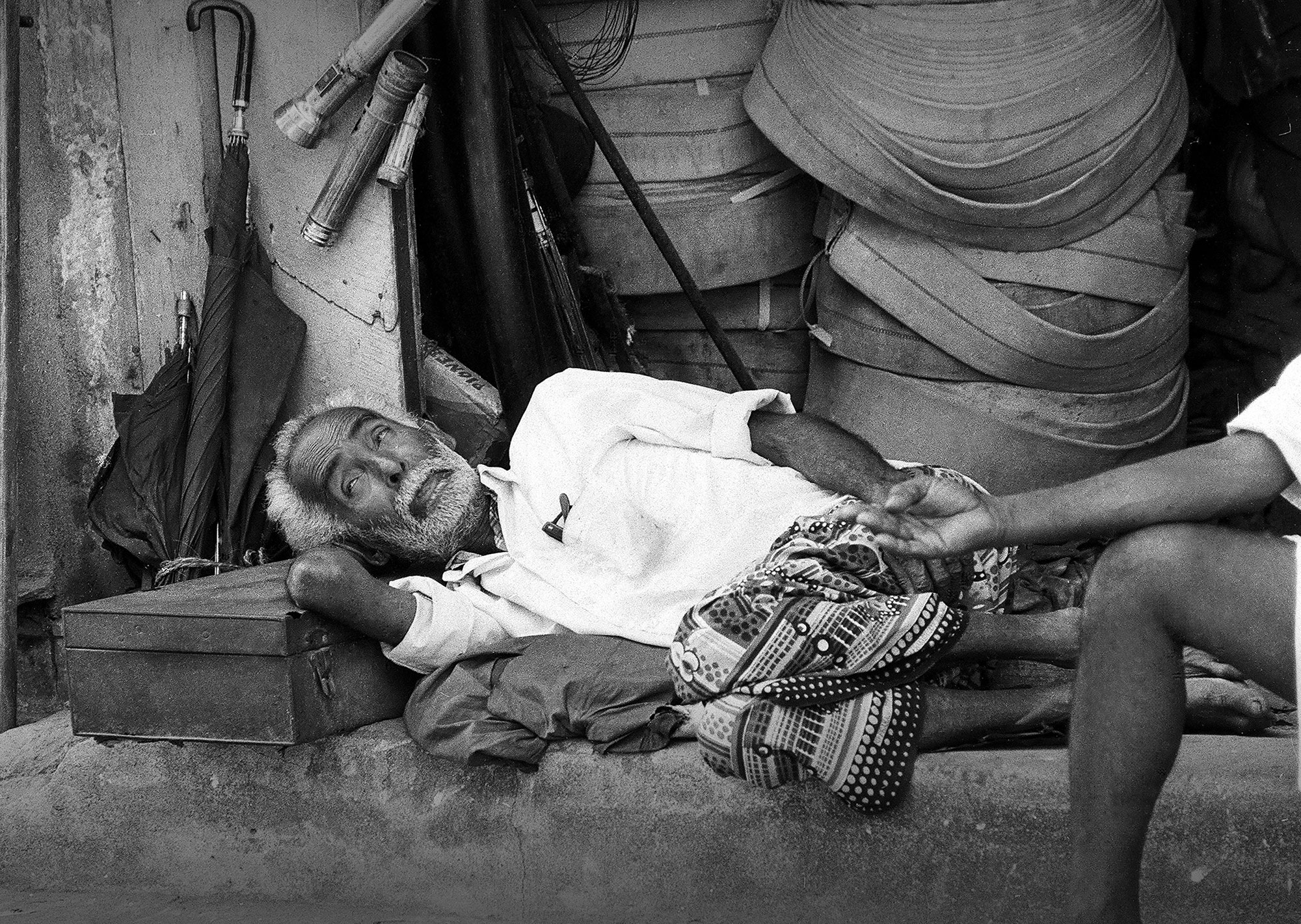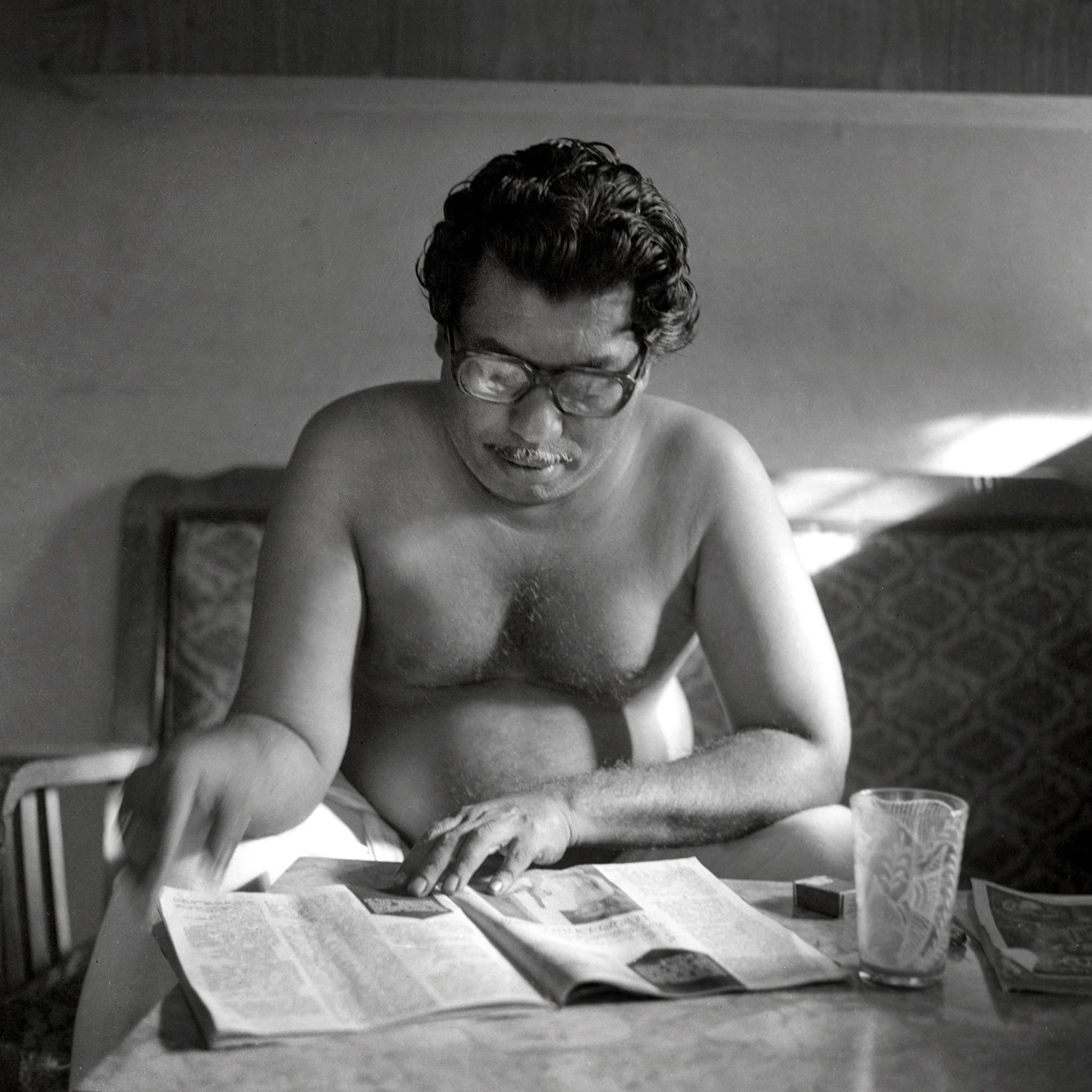Panorama
Digital Moon
and
Analogue
Nights
Photo Mail presents
A panoramic view of
The art of photography’s
Interaction and
Interrelation with other
Art mediums such as literature
Architecture, and
Other visual media
In this autobiographical
memoir Abul Kalam Azad
discusses his versatile journey
as a photo-artist, drawing
parallels to the socio-political
context, personal history
and art. The acclaimed
pieces were originally
published in the popular
Malayalam journal
Deshabhimani for
over a year (2019 – 2020)
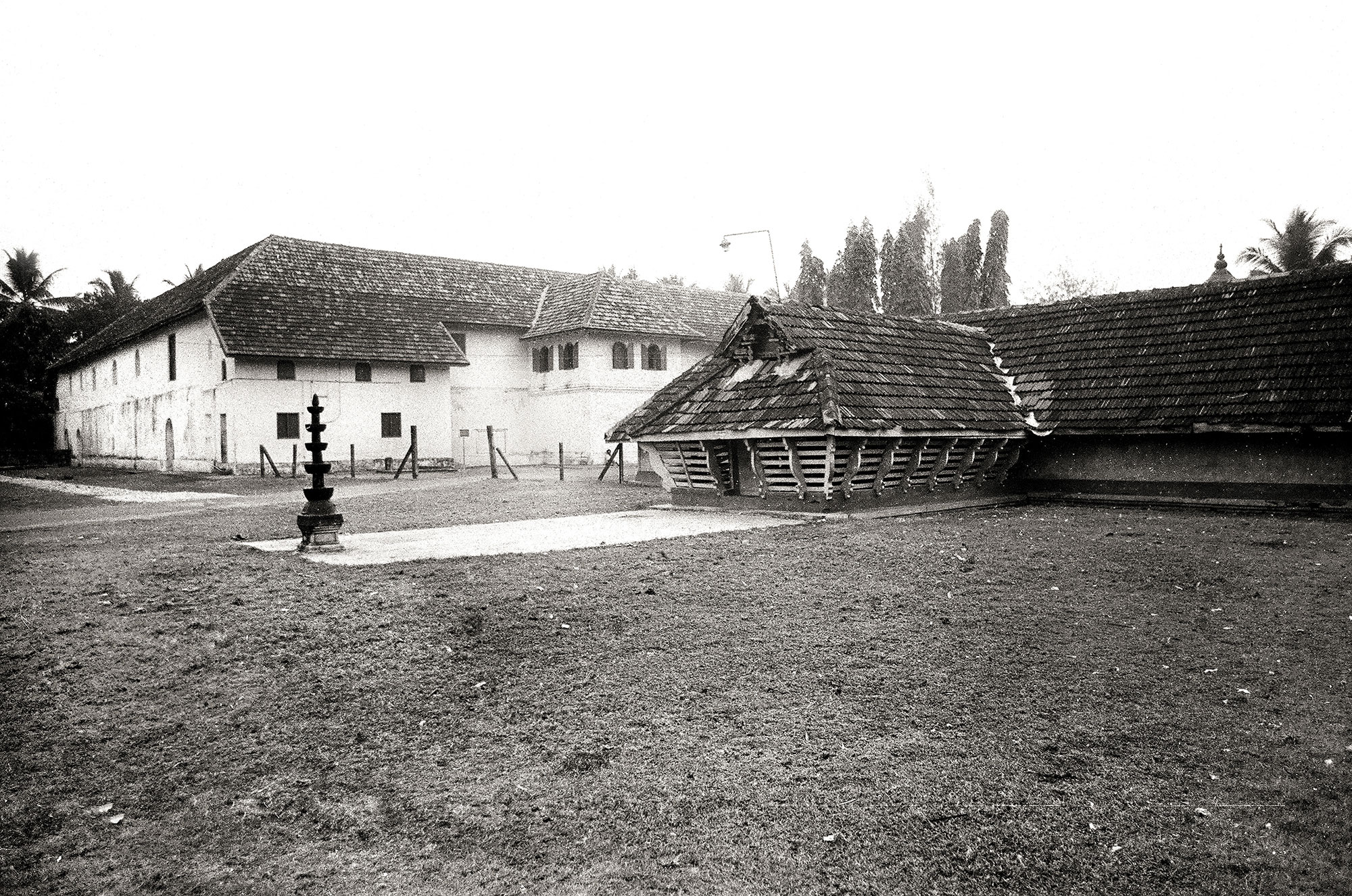
Mattancherry Palace © Abul Kalam Azad 1980s
Mattancherry has been a microcosm of authentic cosmopolitanism, many ethnicities and faiths coexisting together, with its beautiful contrasts and combinations. I grew up there, in one of its small boroughs called Kochangadi. This Muslim dominated waterfront settlement had – and still has – a few Jewish, Ezhava and Christian families. Apart from a synagogue and a few churches, there are several small and big mosques that belong to different ethnic groups or factions of Muslims such as Kutch, Bohras, Ravuthars, Nainas, Patans and more. The most prominent of those masjids, Chembittapalli – literally means the mosque roofed with copper sheet – was closely associated with the Nainas who originally hailed from Kayalpatnam, an ancient port town in southern Tamil Nadu. It was where my grandparents had been buried and every Friday, my family would visit the Chembittapalli for Ziyarat. As a young boy, I preferred praying in the attic which had intricate wooden carvings. Adjacent to this mosque is a pond called Andankulam – meaning a pond owned by a king or ruler, in Tamil. During my childhood, every year someone would drown in this deep and large public pond. Scared, several families, including mine restricted their children from entering its vicinity. Alas, I never learned swimming.
Mystics and mysticism are a visible presence in Mattancherry’s popular culture. Incredible mythical stories of miracles and superhuman prowess surround several dargahs and shrines of mystic men and women, of different religions. The magical tales often crossed the borders of faith as believers from all faiths would visit, pray and give offerings to a Jewish or Islamic or Christian saint, with no inhibitions or restrictions. The grave of Makhdoom I at Mahalarapalli was the most famous of them all. There was another popular Jewish mystic shrine dedicated to Nehemiah Ben Abraham Mutha. I still remember the peculiar offerings to these different sacred sites. At a shrine in Pandara Parambu, dedicated to an unknown Beebi, the offering was thread and needle. To KappiriMuthappan, it was cigar and arrack.

Mattancherry Market © Abul Kalam Azad 1980s
I remember my father narrating the story of Narayana Guru’s visit to the island. During his younger days, waterways were active and thriving. Before auto rickshaws were introduced at a later stage, the only way to commute within the islands was cycle and hand pulled rickshaws. Narayana Guru’s host was an Ezhava landlord named Thakyavu Krishnan, who kept a dedicated rickshaw for the exclusive use of Narayana Guru, as my father explains. As soon as Guru disembarked from the Mattancherry boat jetty, the rickshaw would take him to Thakyavu’s house. Here too, people from different faiths assembled and interacted with Guru.
In the 1980s, the Mattancherry bazaar was still a busy market bustling with people and trade; merchants and workers from far and near used to throng here. It was a vibrant mixture of identities. Men and women from the nearby settlements belonged to varied places: there were people from Malabar, Konkan and Gujarat, some were the descendants of Jewish and Arab merchants who had settled here centuries back. Everyone had his space and stake in the trade and business. Each community specialized in their own preferred products that they were trading for generations. For example, the Gujaratis collected and processed areca nut, pepper and other spices, while the Katch Muslims were focused on sea food. The Syrian (St. Thomas) Christians, the most dominant among the Christian population, mainly traded rice. There were innumerable other small businesses run by different communities. Coir was a popular product. The laborers would throng the banks of the backwaters, loading and unloading, storing up the warehouses or resting and chitchatting. The chaos of buying, selling and yelling in the markets unfolded as if in a perfectly composed orchestra, set against the cacophony of pigeons, crows and sparrows.
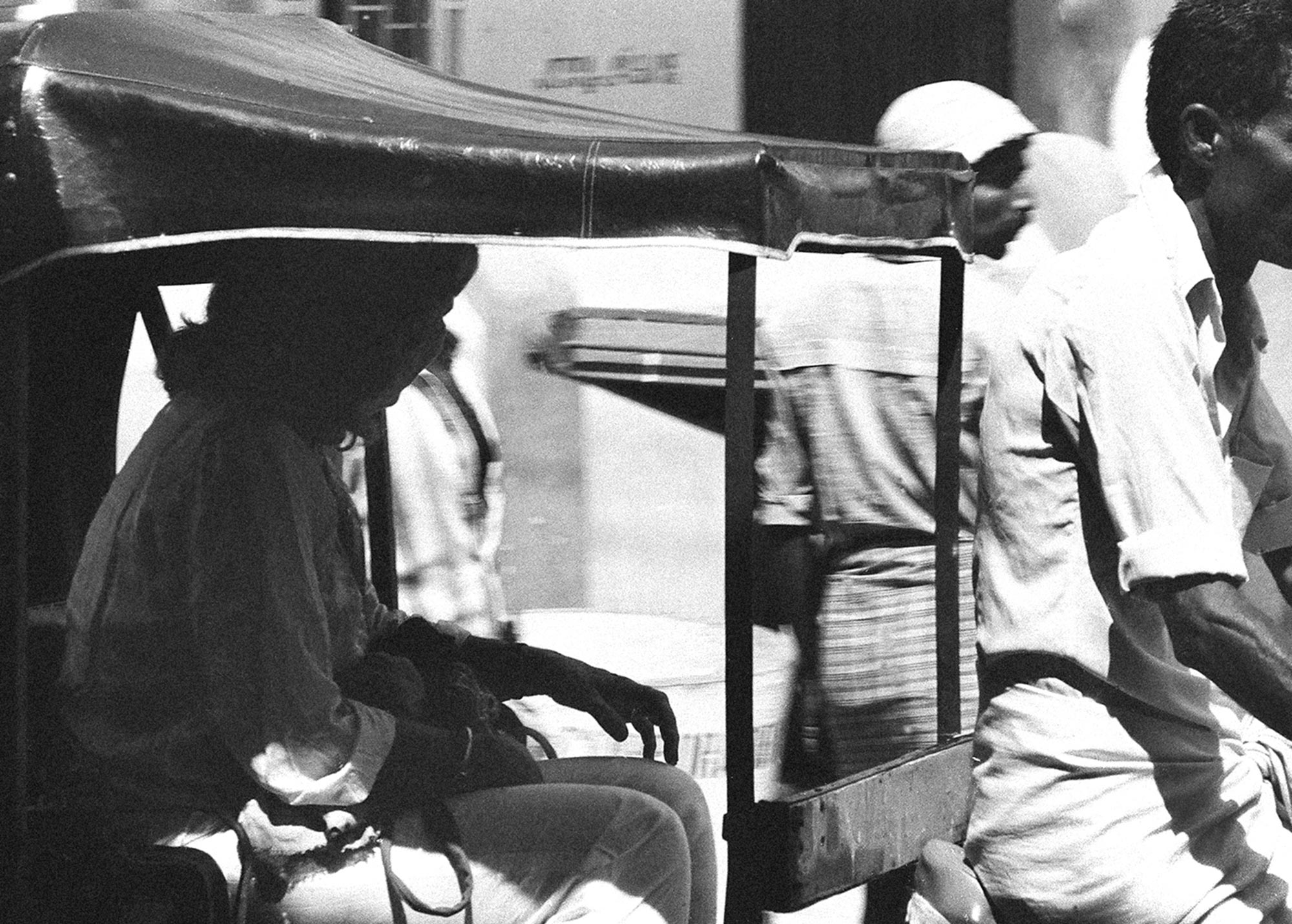
Cycle Rikshaws © Abul Kalam Azad 1980s
I grew up exposed to the diverse tastes of these different cultures. Each community and their subcultures have unique lifestyles, festivals, costumes and food habits. This was much before globalization started erasing individual cultures with homogeneity and uniformity and each community was proud of its culinary traditions. Within the Christian community, Syrian and Latin Catholics had their own special recipes. The same went for Muslims – Mappilas, Nainas, Ravuthars and Kutch Muslims differed from one another in their cuisines. On the other hand, the Jewish tradition was entirely different. As a naughty child, I had to shift several schools and I naturally made friends from almost all communities. Children were welcome in any home, irrespective of religious or ethnic differences, and there was always one festival or the other. Certain hotels and their delicacies were even famous beyond Mattancherry, such as Kaikka’s Biriyani, Shantilal S Mithaywala’s Ghatia Jilebi, Puthu’s famous Konkani Saraswathi Brahmin Idli and Elite hotel Thomman’s cake (Anglo Indian) to list a few.
Architecturally also, west Kochi was diverse and rich. While the European structures dominated the monolithic Fort Kochi, the buildings in Mattancherry were a mix of varied styles, mainly Indo-European. It almost changed from street to street, community to community.
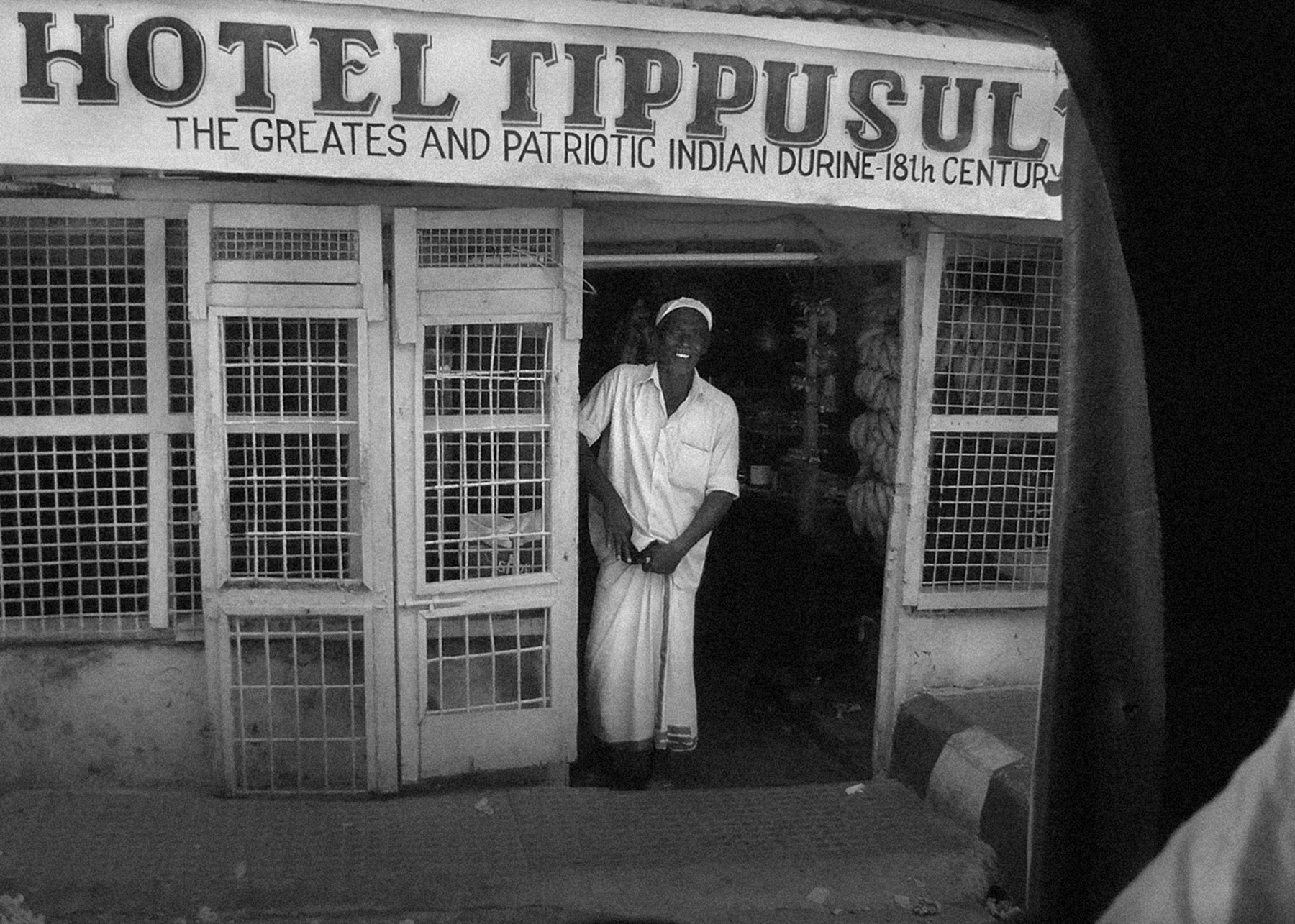
Hotel Tippusultan, Mattancherry © Abul Kalam Azad 1980s
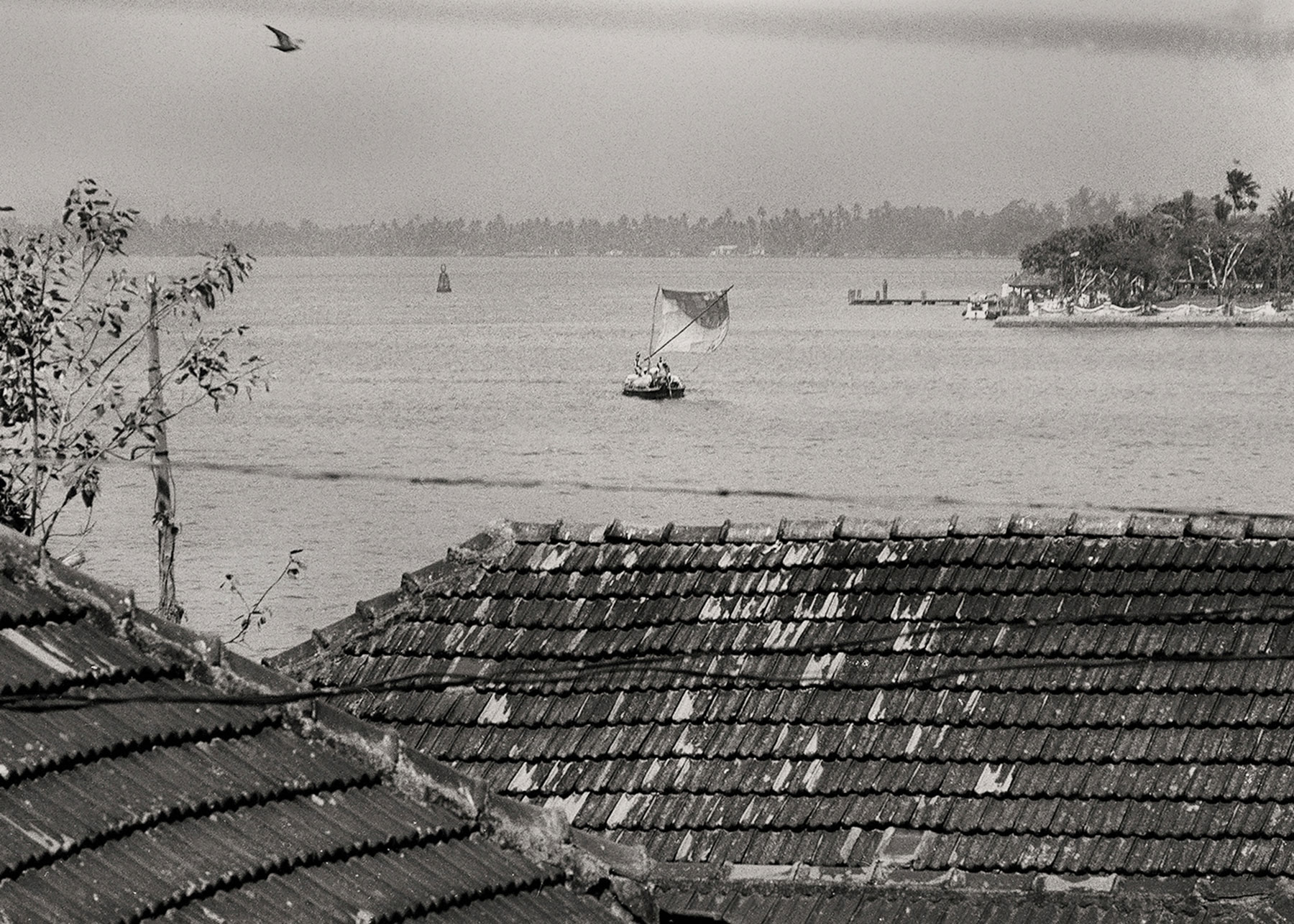
Mattancherry Backwaters © Abul Kalam Azad
A city’s vice and virtue is often etched in its nightlife. Mattancherry’s nightlife marked its character with music and stories. The recreational art, music and sports clubs were vibrant and several. After the days’ heavy work, the local public used to gather to perform or play in the attic of those sleepy warehouses and streets. Music and the refreshing aroma of spices and food plates filled the air throughout the night.
My memory hardly has any incident of caste or religious violence in Kochi, as the people, by and large, cohabited harmoniously. The 32 and odd communities that had traveled across land and sea to settle here, had an unspoken understanding that conflict and tensions were antithetical to trade and business. Hence, all differences, frictions, and even hidden hatred were put aside for the sake of livelihood, economic prosperity and safety. People of any cosmopolitan and progressive settlement prefer peace over divisive politics, I assume.
This early childhood exposure to pluralistic culture and lifestyles enabled me to acquire the qualities of progressive cosmopolitanism. The values I had imbibed from Mattanchery’s air so naturally and authentically turned out to be the foundation for my cosmology and artistic growth. It is in this backdrop, my photographs of the Mattancherry in the 1980s had to be seen. It is a memory project that captures the experience of this spicy town that I once called home. It clearly negates the prejudiced excitement of a visiting tourist. Nor does it provide an exaggerated view of the native practices and lifestyles. It is about the mundane and every day; the normal and the causal. It presents the people whom I saw daily; whose names and stories I knew well. I wasn’t even consciously doing an image-making exercise in this series. There were no predecessors to emulate for me; simply, I was shooting my surroundings and the memories associated with it.
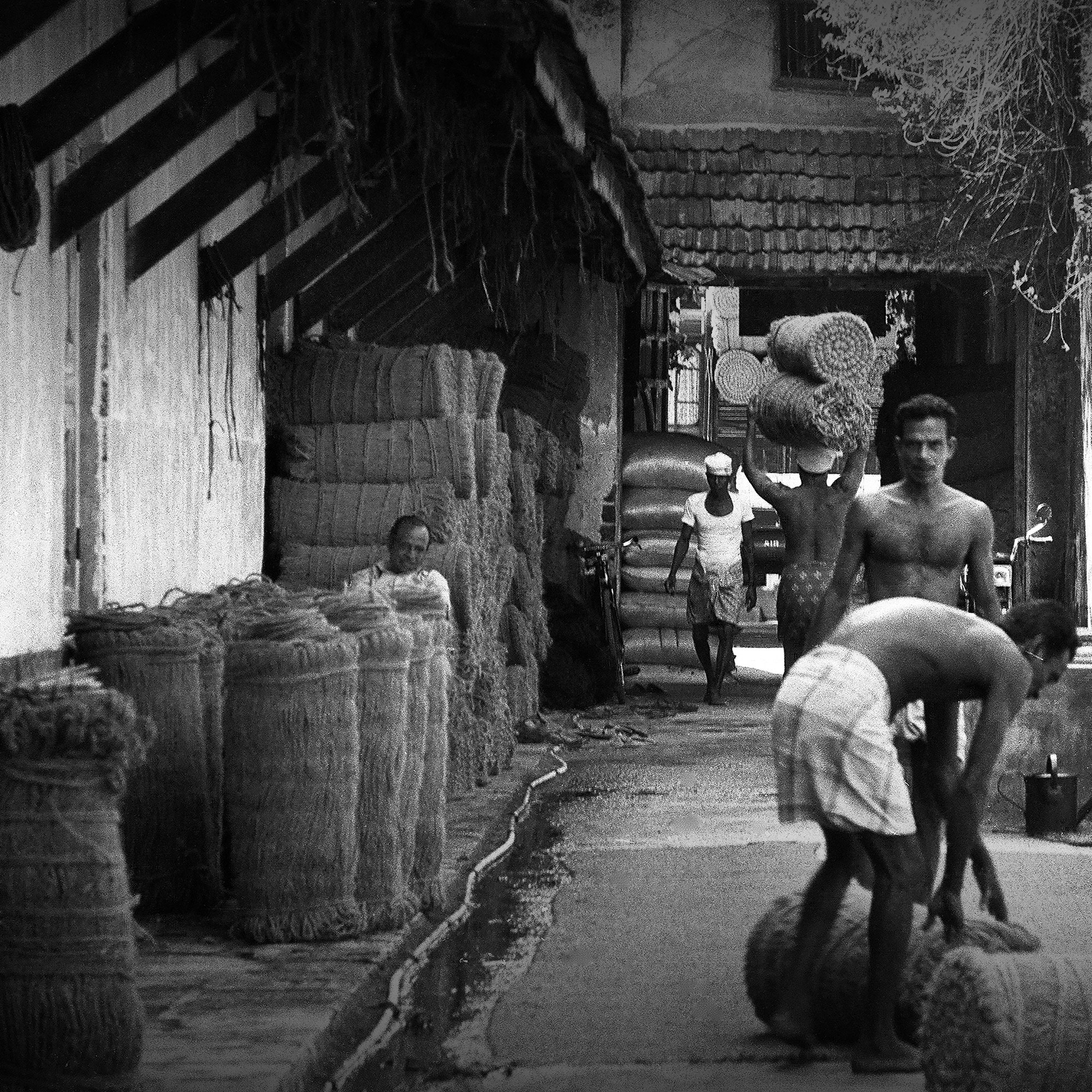
Hand-pulled Rikshaws © Abul Kalam Azad 1980s
Obviously, the process of traditional analog photography is time-consuming and expensive. During the 1980s, access to films and equipment were also limited. Unlike digital photography, one did not have the luxury of taking countless shots within a fraction of a second. So, every photograph required a lot of deliberation and premeditation. Even then, there is absolutely no surety that a photograph would come out well. It was always possible that a person could close his/her eyes. Or a sudden flash of light or movement could hinder the quality of the image. Then, at the developing stage, precise chemical composition was required to get the image right. Like an alchemist, with intent awareness, the photographer uses different permutations and combinations of hazardous chemicals to develop his/her unique style.
Today, with digitization, photography is a mere one-click application. Any tone is a button away, with advanced filters and amazing manipulative possibilities. Much thought is not required, and often trial and error would result in a fairly good image. This easiness is the major reason why photography has become the most popular medium of expression. Integral to this medium is its potential to promote any place as a destination and in that sense, Mattancherry and Fort Kochi have become a visual treasure trove, today.
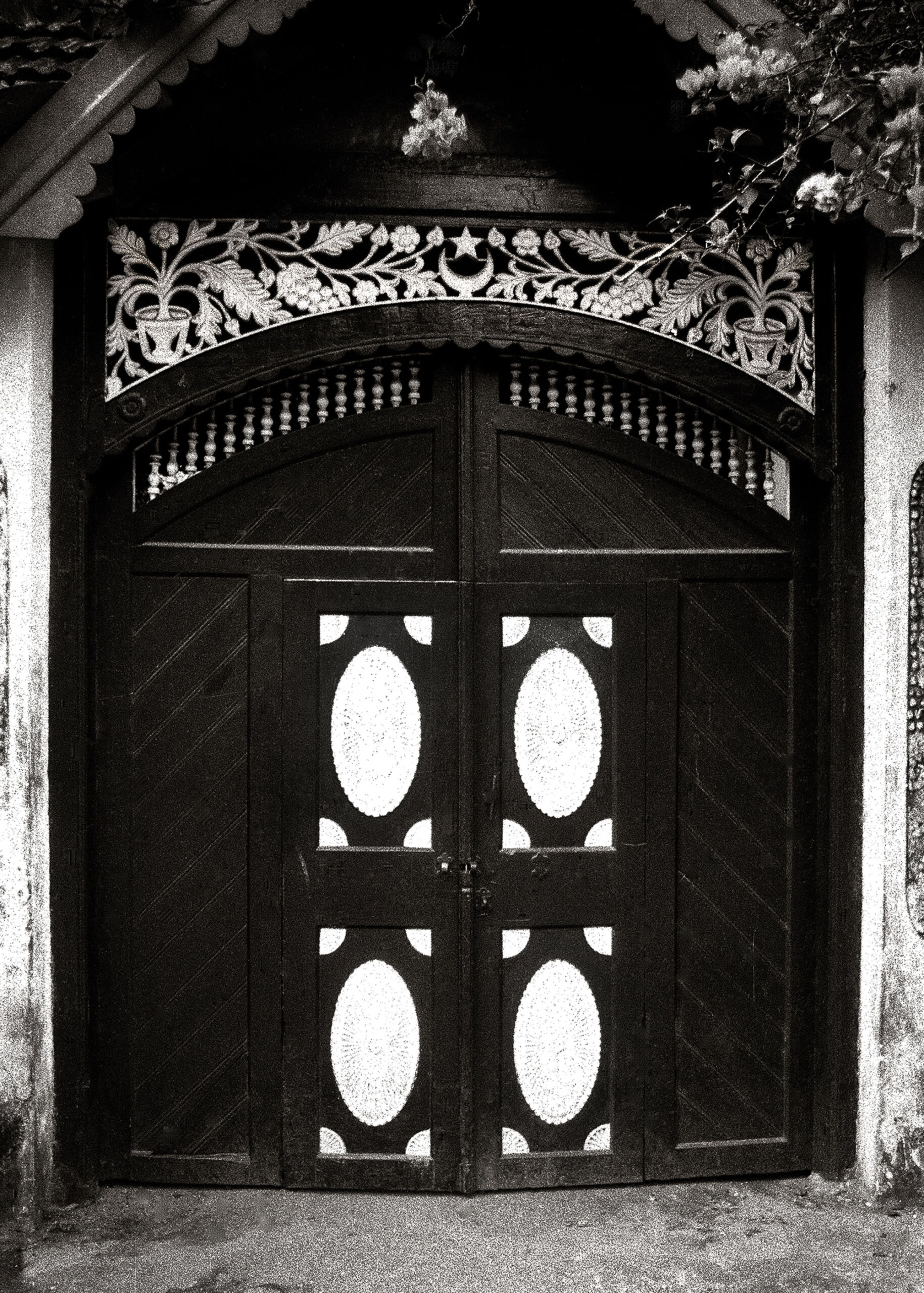
Door to a home © Abul Kalam Azad 1980s
Of all destinations in Kerala, west Kochi is arguably the preferred cultural capital. Its major art events and galleries have created a demand for clichéd photographs of multicultural Mattancherry and subaltern people, often leading to commissioned projects with specific interests. On the one hand, homogenization and globalization are silently erasing its diversity and uniqueness; on the other side, the tourism market demands certain antique traditions and obsolete living conditions to sustain. For instance, the dhobis must remain the same, continue washing with their hands. If they use machines, the primitivism and exoticism is gone and it suddenly ceases to be a tourist attraction. In the west, there are mandatory ethical practices in photography that must be strictly adhered to. In fact, photographing streets is no longer permitted in many countries. In India and other developing nations, because of poor governance and lack of the ignorance of civil rights, there are no systems put in place. Primitive photographs of India are in huge demand and hundreds of Indian and International photographers throng our streets, clicking soullessly and thoughtlessly, mostly producing monotonous images reinforcing the prescribed narrative. The same persons are photographed again and again, for the simple fact that they represent a certain community or religion. People, places and events in the region are being documented as an out-of-the-ordinary thing. Like a zoo.
There is no doubt that documenting a town is of great value and importance. But, limiting it to what the western market and tourism demand is unacceptable. In recent years, Kochi has seen several unprecedented developments, which are historically significant. It includes the making of the Kochi metro, the 2019 flood, the neo-migration of workers from Bengal, Nepal, etc. These incidents are not being recorded at all; they may not have a commercial market at this point, but they are immensely valuable in our developmental history. Thought and Imagination are the two essentials for a good photographic project. The masters used to develop their concept and style over years of diligence and practice. Now, easy reproducibility and imitability make photography a democratic medium. That’s a boon and a curse at the same time. This dichotomy is the beauty of my medium.
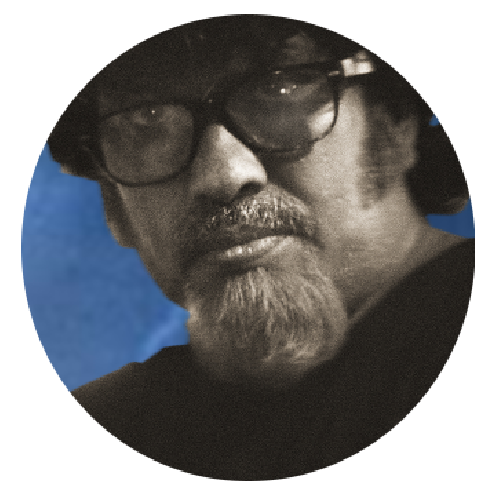
Abul Kalam Azad is an established contemporary Indian photographer, noted for his maverick experimental and conceptual works. He is the Founder Chairman of Ekalokam Trust for Photography. Abul’s photographic works are predominantly autobiographical and explore the areas of politics, culture, contemporary micro-history, gender, and eroticism. His works attempt a re-reading of contemporary Indian history – the history in which ordinary people are absent and mainly provided by beautiful images and icons. To see more works of Abul Kalam Azad check his website.
Published on February 16, 2021
Share
Related Articles
Hitchhiking Days
Most of the Indian photographers learned from their foreign masters and hence, their styles continued to dominate Indian photography. They were either voyeuristic visual trophies that professed, “I had been there, seen that, met him”, or a tool that propagated “top-down let’s-look-at-the-suffering” sort of charity or propaganda of the photographer/client.
Mattancherry: My Cosmopolitan Hometown
Mattancherry has been a microcosm of authentic cosmopolitanism, many ethnicities and faiths coexisting together, with its beautiful contrasts and combinations. I grew up there, in one of its small boroughs called Kochangadi. This Muslim dominated waterfront settlement had – and still has – a few Jewish, Ezhava and Christian families. Apart from a synagogue and a few churches, there are several small and big mosques that belong to different ethnic groups or factions of Muslims.
Sepia Tinted Memory
Our family name is Pattanam, an acronym for the Tamil word Patthanathukarar (which means ‘hailing from a port town’). We could have been from one of the earliest seaports of Tamilakam (the region corresponding to the present South India) such as Kaveripoompatanam (Chola Port Pukar) or Kayalpattanam (Pandyan Port Korkai). Trading took my forefathers to different parts of Tamilakam and they eventually settled in Mattancherry.



